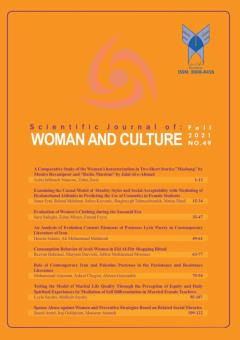Evaluation of Women’s Clothing during the Sassanid Era
Subject Areas : History & Archeology
Sara Sadeghi
1
,
Zahra Mirazi
2
![]() ,
Farzad Feyzi
3
,
Farzad Feyzi
3
![]()
1 - Mohaghagh- Ardabili University, Department of Archaeology, Areabil, Iran.
2 - Mohaghagh- Ardabili University, Department of Archaeology, Areabil, Iran.
3 - Mohaghagh- Ardabili University, Department of Archaeology, Areabil, Iran.
Keywords: Sassanid era, women’s clothing,
Abstract :
The present study aimed to evaluate women’s clothing during the Sassanid era. The research population consisted of the women's images in the reliefs, coins, seals, paintings, stuccos, and tessellations during the Sassanid era. The study sample included women’s clothing in cultural data of this era. The research design was a descriptive-analytical method. The data were gathered via library (documentary) research method by using written sources, field research, and tools such as cameras and taking note cards. The pictures were analyzed using an archaeological data method. The Sassanids' archaeological findings such as metal dishes, reliefs, coins, seals, etc. clearly showed that Iranian women were using a special kind of clothing despite their broad range of political and economic activities. The clothing was inspired by the art and culture of Sassanid kings and artists, and it was mentioned in the Avesta and most importantly, the clothing of Persians during the Sassanid era was a little different from the past so that various kinds of pleated silk and thin clothes such as shirts or tunics, capes, belts have replaced the rough and thick clothes of the past eras. In conclusion, Sassanid women such as goddess Anahita, the queen, and princesses wore clothes, running down to the ankles, a crown on their heads, pearl necklaces, and braided their hair, following the clothing described in Avesta.
Avarzamani, F. (2014). Sassanid art. Tehran: Azineh Publications. [Persian] https://www.gisoom.com/book/1990134
Avarzamani, A., & Sarfraz, A. (2015). Persian coins: from the beginning to Zandieh era. Tehran: Samt Publications. [Persian] https://www.gisoom.com/book/11171543
Behraman, A. (2014). Determination of material and techniques for manufacturing Sassanid decorative mosaics (Bishapour Palace). Beautiful Arts-Visual Arts Journal, 19 (2), 37-48. [Persian] https://www.magiran.com/paper/1310954
Brunner, J. CH. (1979). Sasanian seals in the moore collection: Motive and meaning in some popular subjects. The Metropolitan Museum of Art, Metropolitan Museum Journal, 14(1), 33-50. https://www.journals.uchicago.edu/doi/10.2307/1512736
Dadvar, A., & Neshat, R. (2011). The role of women in Sassanid artworks. Semnan: Abrokh Publications. [Persian] https://www.gisoom.com/book/1822214
Farridnejad, Sh. (2015). The iconography of zoroastrian angelology in Sasanian art and archaeology. Spirits in Transcultural Skies, eds. N. Gutshow, K. Weiler, Switzerland: Springer International Pub. https://link.springer.com/chapter/10.1007%2F978-3-319-11632-7_2
Ghanbari, S. (2007). Reviews the evolution of the discourse of the veil in the Iranian press 70. Thesis in M.A Sciences and Economics College: Alzahra University. [Persian] https://ganj.irandoc.ac.ir//#/articles/60a34081997a658d6c5df937c71b04b1
Ghirshman, R. (1999). Bishapour (V. 2): Sassanid mosaics. Translated by Asghar Karimi. (1999). Tehran: Cultural Heritage Organization (Research Office). [Persian] http://www.lib.ir/book/69969885
Goldman, B. (1999). Women's clothing in the Sassanid era. Translated by Mohsen Zaidi & Mohammad Taghi Sharhataei. (2000). Archeology Research, 5 & 6, 39-47. [Persian] https://www.noormags.ir/view/fa/articlepage/309366
Gregoratti, L. (2015). Parthian women flavios josephus. In Martina Hiscchberger, judisch–hellenistische literature in Ihrem interkulkontext. Peter Lang Verlay, 183-192. https://www.academia.edu/1160199
Harper, P. O. (1978). The royal hunter art of the Sasanian empire. New York: Asia Society. https://www.amazon.com/royal-hunter-Art-Sasanian-Empire/dp/0878480501
Hasani, M. M. (2014). Reviewing the washed-up relief of Sassanid king in Naqsh-e Rostam. Archaeological Studies, 6(2), 21-37. [Persian] https://www.magiran.com/paper/1417369
Jamali, B., Hassani, M. M., & Berhroozi, M. (2020). Women’s social status during Sassanid era (based on seals). Islamic Arts Study Journals, 17(39), 141-158. [Persian] https://www.magiran.com/paper/2243161
Karimpour, Sh., & Piravivanak, M. (2019). Globalization of cuture and traditional clothing of ethnic identities with emphasis on survival of kurdish women's clothing in west of Iran. Woman and Culture, 10(38), 25-42. [Persian] https://iranjournals.nlai.ir/handle/123456789/354592
Mansoori, A., & Karamian, G.R. (2012). Sassanid stuccos in Barze Qawale archaeological site, Kuhdasht, Lorestan. Naqshmayeh Visual Art Journal, 5(10), 73-82. [Persian] https://www.noormags.ir/view/fa/articlepage/1498384
Montasheri, M. (2017). Evaluation of Sassanid stuccos effect on stuccos decorations of 1rd to 5th century AH architecture. Green Architecture Quarterly, 3(8), 55-68. [Persian] http://ensani.ir/fa/article/375079
Mustafavi, M. T. (1957). Scenes of Sassanid bards on the dishes of the Museum of Ancient Iran. Naghsh and Negar, 1(3), 2-13. [Persian] http://ensani.ir/fa/article/270025
Rahbar, M. (2010-2011). Bandian fire temple, Once again. Modarres Archaeological Studies, 2 & 3(4 & 5), 167-177. [Persian] https://www.academia.edu/5005640
Rajabi, P. (2008). The lost millennia, 3rd edition. Vol.5. Tehran: Tus Publications. [Persian] https://www.gisoom.com/book/1596390
Sayyari, M. (2019). Identification and analysis of the effect of Sassanid women’s clothing on Islamic clothing (based on Bishabur mosaics). The first national human science and development conference, Payame Noor University of Fars Province. Shiraz: June 20th. [Persian] https://civilica.com/doc/938699
Schippmann, K. (2005). Basics of Sassanid history. Translated by Keykavous Jahandari. (2008). Tehran: Farzan Rooz Publications. [Persian] https://www.gisoom.com/book/1462396
Talaie, H. (2014). Seals in Iran from the beginning to the Islam emergence. Tehran: Samt Publications. [Persian] https://www.gisoom.com/book/11373043
Vahdati Helan, Y. (2012). The value and status of women in ancient Iran. Tabriz: Akhtar Publications. [Persian] https://www.gisoom.com/book/1838004
Ziapour, J. (1974). An introduction to coloring in Persian artworks from the beginning to Safavid era. Tehran: General Writing Office of the Ministry of Culture and Arts on the occasion of celebration, culture and art. [Persian] http://fipak.areeo.ac.ir/site/catalogue/18495498
_||_

